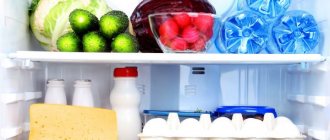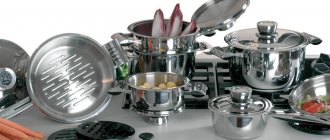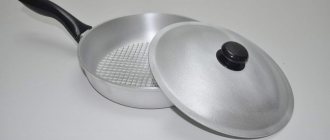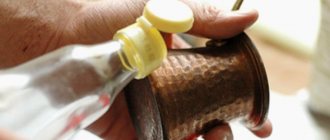Even the most experienced housewives make mistakes while cooking. Burnt milk inside the pan is one of the common problems in the kitchen. To wash dishes from burnt milk, use various means. The most important thing is to start cleaning as soon as dirt appears. How can I clean the pan?
Salt
Fill an aluminum or stainless steel pan with cold water and let it sit for 10-15 minutes. Then drain the water and fill the bottom with salt. After 2-3 hours, remove the salt from the dish and rub its inner surface with the hard side of the sponge. It is not necessary to use detergents. The enamel pan must first be removed from the stove and allowed to cool. Do not fill it with water immediately so that the enamel does not peel off. Then follow the steps described above. If carbon deposits remain, repeat the procedure again.
Reasons for milk burning in a pan
If we go into physics, milk consists of polymer molecules. When heated, the molecules “stick together” into a film that adheres to all solid surfaces. It burns especially often for the following reasons:
- do not stir the milk;
- the pan is closed;
- the fire is turned on very high;
- The milk has boiled but continues to cook.
To avoid burning, you need to:
- use a pan with a thick bottom;
- pour cold water over the dishes - milk sticks less actively to cool metal;
- grease the walls with oil (butter and vegetable);
- pour no more than 60% of the milk from the total volume of the pan;
- stir constantly;
- leave dishes open;
- remove from heat immediately after boiling (it is not enough to turn off the gas - you need to move it to a cold area of the stove).
Vinegar
This method is more suitable for aluminum cookware. Pour vinegar into the pan, cover it with a lid and leave for 2 hours. Then drain the liquid and wash the dishes. Vinegar is good because in addition to burnt milk, it will also remove dark spots from aluminum products. It is better to fill enamel pans with a solution of vinegar and water.
Read also: How to clean frying pans made of different materials from carbon deposits?
Oven cleaning rules
Removing stains from a down jacket after washing
Errors when cleaning
Housewives often spoil dishes if they are not cleaned properly, so all that remains is to throw them away. Do not allow this outcome and remember what things you should never do:
- clean the enamel with metal meshes and coarse bristles. They will leave behind scratches, the coating will quickly become unusable;
- use washing powder or other products unsuitable for washing dishes. They can become firmly embedded in the surface, and during cooking penetrate into food and cause poisoning;
- use cleaning products with large abrasive particles. Just like hard metal brushes, they leave marks on the enamel.
If you are unsure how the product will react with the material, treat a small area first and wait time. If nothing happens to the coating, then feel free to apply the powder or gel to the entire area of contamination.
Soda
If the pan is damaged not only inside, but also outside, then it is better to boil it entirely in a soda solution. To do this, prepare a metal container of a larger volume than the affected dishes. Remove all plastic elements from the latter and prepare a solution at the rate of 500 g of soda per 5 liters of water. Place the dirty item in a container and fill it with solution. The liquid should completely cover the pan. Bring the water to a boil and leave on low heat for 2 hours. Remove the container from the heat, drain the liquid and wait until the pan dries. Then wash it with a sponge. This method is suitable for any pans.
You can also use a mixture of baking soda and salt. Fill the bottom of the dish with it and pour a small amount of warm water inside. The result should be a thick paste. Cover the pan with a lid and leave for a day. Then remove the mixture and boil plain water in a saucepan. Wash the product. This method is not suitable for stainless steel cookware as stains may appear on its surface.
Features of cleaning pots made of different materials
The material from which the cookware is made affects operation and cleaning.
Enameled
Carbon deposits are easily washed off the enamel. Therefore, they do without chemicals, salt and other aggressive agents. It’s better to just wash it with dish gel, and when that doesn’t help, boil it with soda. It is not advisable to rub the enamel too much - it will rust.
Stainless steel
Stainless steel is also quite easy to clean. The material can be rubbed with abrasives, but only with fine-grained ones:
- do not use powders with large crystals (salt, citric acid, powdered “Shumanit”);
- wash with a soft kitchen sponge;
- It’s better not to boil – it doesn’t spoil the stainless steel, but it does darken it.
Made of aluminum
Aluminum heats up quickly and the milk boils in a couple of minutes. But it burns almost immediately after boiling. Therefore, you need to constantly monitor the milk in an aluminum pan and turn off the gas in time. If the liquid still burns, then the aluminum is cleaned according to the following rules:
- wipe only with a soft cloth or sponge;
- do not use acids - they cause the metal to become covered with dark spots.
Non-stick coating
These pans, as you might expect, rarely burn. Milk deposits will only appear if you forgot to turn off the gas and the milk takes a long time to boil away. Carbon deposits can be cleaned off quite easily, but with 2 conditions:
- wipe the walls and bottom of the pan only with a soft dish sponge;
- Do not use bulk products - scratches will damage the coating.
Lemon acid
Prepare a solution: 30 g of citric acid per 5 liters of water. Pour it into the pan and put it on the fire. Boil for about 1 hour. Drain the solution and wash the dishes. The method is only suitable for enamel pans.
If you don’t want to soak dishes for a long time and prepare cleaning products yourself, then buy a special preparation. In modern hardware stores, such products are presented in a wide range. Before purchasing, consult with the seller and read the manufacturer's recommendations.
What is better not to do
| Ban | Description |
| Boil milk in an enamel bowl | It was said above that plaque is easily washed off from the enamel. But it appears - also much easier than in other types of pans. If you have to clean the pan often, the enamel will wear off, even if you're careful. |
| Leave carbon deposits in the pan | When it's burnt, you need to clean it right away. If you cook food in a pan stained with carbon deposits, the thermal effect will cause it to “take root” deeper and become impossible to remove. |
| Pouring aggressive chemicals inside | It is better to use chemicals only to clean the outside of the pan. A small amount of the product risks remaining on the walls of the dishes and getting into the food, which is unsafe. |
| Rub with a metal brush | A pan made of any material does not withstand the impact of a wire brush. Wide scratches remain in which microparticles of food get stuck and give the pan an unpleasant odor. |
Compliance with safety regulations
To avoid harm to your health, take care of your safety and follow the safety rules:
- use durable rubber gloves even when working with mildly aggressive substances;
- pour loose powders in small portions so that dust does not scatter throughout the house;
- when working with caustic substances, wear a respirator, open the vents and windows in the house, and even better, clean in the open air;
- When cleaning, cover all parts of your body: wear pants, sweaters with arms, socks. Do not allow chemicals to come into contact with the skin;
- Once the surface is clean, rinse the pan with water repeatedly. To be more convincing, boil a couple of liters of water in a container for half an hour. You can add lemon juice, it neutralizes the remaining chemical elements.
If you follow the advice, you will definitely not have any problems during processing. If you are distracted and accidentally allow household chemicals to come into contact with your skin, immediately wash it off with water.
If the skin at the site of contact with the chemical becomes very red and causes pain, you should consult a doctor.
How long to boil milk
You can simply not leave the stove for a minute. Milk should be simmered over low heat for 2-3 minutes after boiling, while constantly stirring it and removing foam. Foam from milk should only be removed during boiling. After the product has cooled, the film should not be removed, since it contains the bulk of the useful substances.
To increase the shelf life of milk, you can add sugar to it when boiling (1 teaspoon per 1 liter of milk). Milk should be stored in an airtight container (milk tends to absorb various foreign odors) in the refrigerator. Pasteurized milk should not be boiled, since this product has already undergone heat treatment (up to 80 degrees for some time) and all pathogenic bacteria in it have died.
First of all, you should clarify what kind of milk
.
If you bought it in a bottle in a store, then you don’t have to boil
.
But if you purchased milk either at the market, or from some imported tank, then, of course, you must boil it. The best option to milk
from burning is
to boil
it in any pan with a thick bottom.
Recommendations from nutritionists on how long to boil milk
, different.
nutritionists
advise boiling milk for at least 10 minutes.
This, in their opinion, is necessary in order to destroy harmful substances and bacteria in milk. However, the vast majority of nutritionists disagree about the “10 minutes”, since during this time the milk will simply “run away”. Therefore, they recommend boiling the milk
over high heat only until it is completely warmed up and boils away. According to experts, even in this short time, all harmful microbes will be completely destroyed.
Often a coating forms along the edges of the pan and on its bottom, so to avoid it, try to rinse the pan with water every time. Boil milk
need to be on high heat.
To prevent the milk
from boiling over, always place a circle at the bottom of the pan (you can purchase this at a hardware store).
But you can do without a mug - just grease the edges of the pan with some kind of fat. And stir the milk
, otherwise a film will form.
If, for example, you are at the dacha and there is no refrigerator, and at the same time you want the milk
not to spoil for several days, boil it in the morning and evening, but do not cover it until it cools down.
Our magazine is about health, so in our regular column “Healthy Eating” we talk about a product in each issue. Today our story is dedicated to such a popular product as milk.
.
How is it useful? What types of milk
?
How can you tell if milk
? The column is led by doctor V.V. Laidinen.
All about milk
Milk
occupies an important place among food products because it is easily digested and well absorbed by the body.
Milk
has high nutritional and biological value, and this is primarily due to the presence of proteins in it.
Milk
proteins contain all the elements necessary for our body, which are needed by both an adult and a child.
Thus, milk protein contains the amino acid methionine, which is necessary for normal liver function. In addition to proteins, milk also contains fat, amino acids, minerals, various vitamins, calcium salts, magnesium, phosphorus, sodium, potassium, iron, and all of them are perfectly absorbed by the body. Milk
contain animal protein, which is not inferior in value to that contained in meat and fish. It is worth noting that some substances necessary for the body exist only in milk.
Milk
and dairy products are the most important sources of calcium, which, together with fluoride, determines the efficiency of absorption of this product.
There are such types of milk
as drinking, baked, sterilized, pasteurized and skim. Let's look briefly at each of these types.
Types
of milk
So-called drinking milk
, as the name implies, is produced so that it can be drunk immediately.
Baked milk
is characterized by the fact that during its production heat treatment is carried out, and the color of the milk and its taste depend on this.
Sterilized milk
is milk heated under pressure to a high temperature.
This is done to ensure that all vitamins are preserved. However, living bacteria, which are also beneficial to the body, are killed during this process. Therefore, the quality of sterilized milk
is still worse than that of pasteurized milk.
When sterilizing, cow's milk is used, as well as fresh skim milk. milk
tastes like boiled or sometimes baked milk.
To ensure that sterilized milk is well preserved, it is poured into special bags in which the product can be stored from 3 days to 6 months. However, an opened package can be stored in the refrigerator for no more than 3 days. This milk
is different in that it is heated to a temperature of 70°C for half an hour, which allows you to preserve all the beneficial microelements.
This milk
can be stored for no more than 36 hours.
Skim milk
is very beneficial for older people and those who are overweight.
Milk
bags can be stored longer than bottles, which must be stored in a dark, cool place.
If you are going to boil milk,
you should remember that after boiling it must be quickly cooled, and it must be stored chilled.
How to find out if
the milk in front of you is real or diluted
the milk in front of you is real
or it is diluted, you need to drop the milk into a glass of water.
If a drop spreads over the surface of the water, then the milk is diluted. If the milk
is undiluted, then a drop of whole
milk
will fall to the bottom of the glass and dissolve there
.
How much milk to drink per day
According to medical nutrition experts, a person should drink 400-500 grams of milk per day,
i.e. approximately two glasses. It is best to use low-fat, sour or unpasteurized.
Who can drink
milk and who can't
Milk
useful for people with diseases such as atherosclerosis, chronic liver and gallbladder diseases, hypertension.
In general, milk
is good for people of all ages.
Although it may cause stomach upset or heartburn in some people. In this case, you can try drinking milk
half and half with tea.
If in this case the milk
“doesn’t work,” then there is the option of trying
lactose-free milk
.
This kind of milk has now begun to appear in stores. In addition, milk
is not recommended for acute intestinal diseases, as well as for exacerbation of chronic diseases that are accompanied by diarrhea.
People who cannot drink milk
or it is contraindicated for them can consume fermented milk products: kefir and yogurt.
Village fresh milk is considered a real storehouse of useful and healing substances. As you know, during heat treatment a huge proportion of beneficial vitamins and elements are destroyed, but even under this condition, many information sources recommend boiling raw milk.
Removing the burnt inside: sequence of actions
Tableware enamel requires special treatment. Therefore, before directly cleaning a burnt pan, you need to perform the following steps:
- The fight against carbon deposits cannot be postponed until later. Otherwise, it will be extremely difficult to wash it completely. Therefore, as soon as the pan is burnt, the dish must be placed in another dish; this can be done at any stage of cooking.
- Determine the type of coverage. If it is glossy, then you can start resuscitating it immediately. If it is matte, then the container should be cooled first. Glossy enamel is more durable and easily tolerates temperature changes. For a matte finish, a sudden change in temperature is detrimental.
- You should not try to clean the carbon deposits without soaking. An ordinary sponge will not do this, and metal dish brushes will damage even the most durable enamel. At first, barely noticeable scratches will appear on it, then cracks, and then chips. The soot is generously sprinkled with table salt, soda or filled with dishwashing gel, pour a little hot water into the container and wait for several hours (preferably 8-10).
- When the specified time has elapsed, boil the solution of salt, soda or gel for about a quarter of an hour, cool and clean the container from sticking with a foam sponge. If the desired effect cannot be achieved, additional cleaners will be required.
How long to boil?
How long does it take to boil milk? Nutritionists disagree on how long to simmer it. Some doctors recommend doing this for ten minutes or even longer to ensure that all harmful microorganisms are destroyed. But many nutritionists advise boiling milk until it begins to boil away.
So how long should you boil milk? It is believed that harmful microorganisms will be neutralized even in a short time. In addition, the shorter the duration of heat treatment of milk, the more nutrients it will retain.
Chemicals – quick removal of contaminants
You can clean dishes from stains caused by burnt milk using household chemicals. They are offered by manufacturers in a huge variety for different types of kitchen utensils. Before using them, you must study the instructions.
In most cases, the selected product is applied to the surface of the dishes using a sponge and left for the specified time. After that, traces of burnt milk can be easily removed by simply washing under running water. Modern high-quality chemicals are highly effective. With their help, the most difficult stains can be easily and quickly removed.
Attention! All manipulations to remove contaminants from burnt milk on pans when using household chemicals must be carried out with gloves.
Even if it happens that the milk in the pan burns, you should not be upset. There are many ways to clean stains and restore the attractive appearance of dishes. Moreover, most improvised means are absolutely harmless and are always at hand.
How to care for a stainless steel pan
During use, a layer of grease begins to form on stainless steel pans over time, which can accelerate the wear of the surface. Caring for dishes involves daily high-quality cleaning.
- After completing the cooking process, the dishes must be washed with sufficient water and detergent. This will prevent the possibility of dark spots from appearing and will get rid of dried-on food particles. It should be remembered that, according to the recommendations of stainless steel cookware manufacturers, the process of washing it must begin some time after use. This will protect the coating from destruction due to sudden temperature changes.
- Stainless steel pans are not recommended to be cleaned using abrasives or metal scrapers, which may scratch the surface.
- The use of dishwashers is not recommended. It is advisable to wash dishes in warm water using soft sponges. However, if the information in the product operating instructions confirms the possibility of using a dishwasher, it is advisable to carry out the procedure of pre-soaking the dishes in a soap solution. This will make it possible to more effectively and safely deal with various types of pollution using modern technology.
- After finishing washing, it is advisable to wipe the pan dry, as drops of water on its surface can cause stains.
- It is best to wipe dishes with point movements, giving the surface not only ideal cleanliness, but also smoothness.
- You can use raw potatoes to add shine to stainless steel items. Cut it in half and wipe the entire surface of the pan with these halves.
Cleaning pots using the methods listed above will ensure the dishes look great and will also ensure their long-term use. In addition, homemade cleaning products can be the key to reasonable savings and guarantee an excellent effect comparable to purchased analogues.
Care Tips
Enameled cookware will last for many years if you care for it properly. If you take care, it will always shine clean. To do this, remember a few tips:
- Do not cook milk soups in an enamel pan, do not use it to heat milk. Burnt product is difficult to introduce;
- If you recently bought a saucepan and have not used it yet, fill it with water and boil for 20 minutes before cooking. This will harden the material;
- Choose a burner size for dishes of the appropriate diameter. If you place a large dish on a small burner, heating will occur unevenly, which means cracks will soon form on the coating;
- Wash the pan every time after cooking with lemon juice or acetic acid. They will remove a small coating;
- Do not place hot dishes in the refrigerator or on the balcony at low temperatures. Enamel does not tolerate sudden temperature changes;
- handle the utensils with care: after use, wash them, wipe them dry and put them in a closet for storage. Rust should not be allowed to form as it gets into the food during cooking. Moreover, if handled carelessly, chips and cracks appear on the surface.
If you start cleaning in a timely manner using any of the proposed methods, your pan will be saved. In the future, never leave dishes unattended on the stove while it is on to avoid trouble. With proper care, an enameled product will serve you for decades.
Boil or not?
True, this procedure also has its disadvantages. High temperature not only destroys bacteria, but also destroys vitamins and microelements contained in unpasteurized milk, and also changes the structure of milk protein. The longer a product is cooked, the less vitamins remain in it. Nevertheless, even after this procedure, a sufficient amount of useful substances is retained in the milk. But if you don’t boil the milk you buy by hand, there is a risk of contracting some unpleasant disease, such as E. coli or salmonella. So be sure to boil unpasteurized milk!
Burnt oil, fat
To remove fat deposits remaining on the surface after cooking, a paste of laundry soap and soda is suitable, applied to the problem area in a thick layer.
Any complex stains can be effectively dealt with using folk remedies, which are found in every home. If you don’t have time and have the desire to quickly deal with the fumes, it is recommended to use any chemical product sold in specialized retail chains. The article provides detailed information on how to clean a burnt pan without harming its surface.











